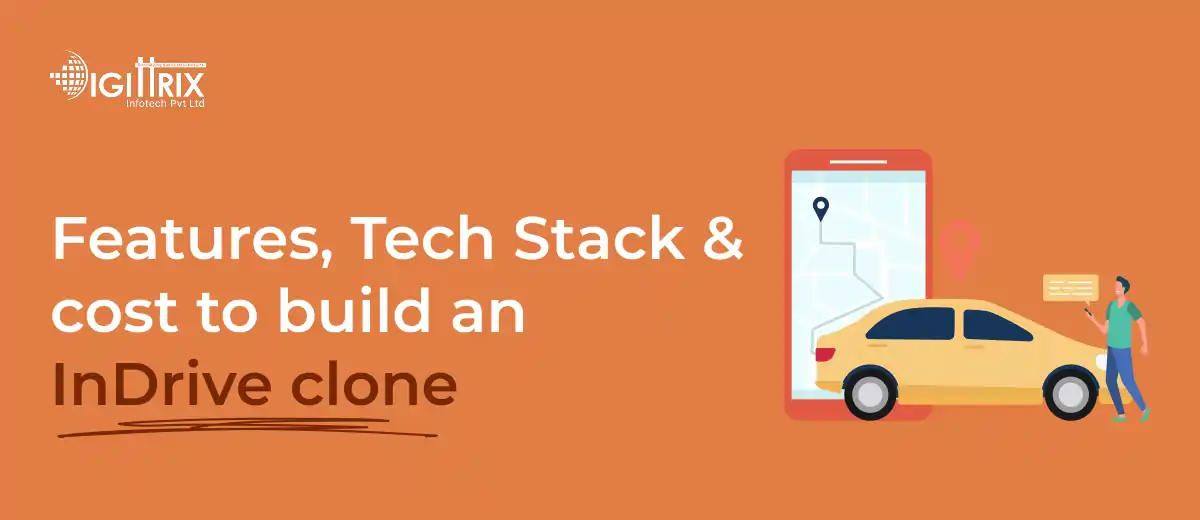In the past 2 years, global demand for InDrive-style apps has increased by 40%, showing strong interest in flexible ride-sharing platforms worldwide.
Highlights
With Over 14 years of Experience in the IT Field, Helping Companies Optimise there Products for more Conversions

InDrive has become a distinctive player in the ride-hailing industry with its user-driven pricing model. Unlike other apps where fare estimates are fixed, InDrive allows passengers to suggest a price, and drivers can accept, reject, or counteroffer. This model not only benefits users but also offers more flexibility for drivers. Due to its popularity and expanding user base, many startups and entrepreneurs are now looking to develop an app similar to InDrive. This article provides a comprehensive guide on how to create an InDrive clone, covering key features, tech stack, and overall development costs.
Looking for the top ride‑sharing options in 2025? Check out this comprehensive guide to the best ride‑sharing apps of 2025.
The growing demand for ride-sharing solutions, particularly those that give more control to users and drivers, makes an InDrive-style platform appealing for businesses. Different from traditional taxi booking systems, InDrive stands out by enabling negotiation between the driver and the rider.
Developing an InDrive clone app could be a smart move if you're looking to enter the ride-hailing market with a competitive edge. These apps can cater to various markets, from cities with limited taxi services to areas where users prefer flexible pricing.
To develop an app similar to InDrive, your platform needs to provide a comprehensive set of features that effectively cater to both riders and drivers. Below is a breakdown of essential features categorised for users, drivers and admins.
When developing a carpooling app, adding a few extra features can improve usability.
The success of any mobile app relies on choosing the right technologies. Below is a suggested tech stack for developing a ride-sharing app like InDrive.
This tech stack can provide a stable foundation for a mobile app development project that functions across regions and devices.
The development of an InDrive clone app typically goes through several important phases. Here’s a step-by-step breakdown:
Start by analysing your target audience and deciding the geographic scope of your app. Understand local transport regulations, user habits, and pricing expectations. This phase also includes finalising features, app structure, and budget estimation.
Focus on designing an easy-to-use interface for both riders and drivers. A clean layout, simple menus, and intuitive icons are vital for an app in this category. The design should support both light and dark modes and adapt to different screen sizes.
With the design finalised, the development team starts coding both the front-end and back-end. This is where all features like fare bidding, GPS tracking, chat, and payment processing are integrated. In a typical taxi booking app development cycle, this is the most time-consuming phase.
Before launch, thorough testing is essential. QA teams should check for bugs, broken flows, loading times, GPS accuracy, and app crashes. Both manual and automated testing are needed to confirm everything functions as expected.
Publish the app on Google Play Store and Apple App Store. You will require developer accounts on both platforms. Use pre-launch marketing and user onboarding videos to inform new users about how your platform works.
Regular updates, bug fixes, and performance checks are essential. Gather feedback from users to enhance the system further. You may also require a dedicated support team to address user questions and technical problems.
The cost to build an app like InDrive depends on multiple factors, including:
Total Estimated Cost: USD 35,000 – USD 60,000 (INR 29,75,000 – INR 51,00,000)
This is based on average development rates. Teams from regions like Eastern Europe or South Asia might offer more affordable options.
If you're planning to work with a mobile app development company, ensure they have prior experience in ride-sharing or carpooling app development.
Thinking about ride‑sharing innovation? Explore how to build a ride‑sharing app, including key features and cost estimates.
Creating an InDrive clone calls for careful planning, skilled developers, and a clear grasp of what users and drivers require. This approach works well in cities where riders appreciate fare flexibility and where competition among drivers helps keep prices fair.
Whether you’re entering the ride-sharing industry for urban commutes, intercity travel, or specialised niches like women-only taxis, an InDrive-style platform can offer a fresh alternative. Developing a taxi booking app with features that cater to both users and drivers can help your platform stand out.
To succeed, concentrate on providing an intuitive experience, rapid support, and consistent updates. Picking the right ride-sharing app development partner can make all the difference in launching a stable and scalable product.
Looking to launch your own fare-negotiation-based ride app like InDrive? With urban travellers seeking flexible and budget-friendly options, building a custom ride-sharing platform is a timely and clever business move.
At Digittrix, we specialize in ride-sharing app development and taxi booking app development, offering complete solutions tailored to your business goals. Whether you're starting from scratch or aiming to develop a feature-rich InDrive clone app, our team is ready to help. We create secure, fast, and user-focused mobile app solutions that support dynamic models.
Curious about the cost to develop an app like InDrive in 2025? We’ll guide you through each stage—from planning and design to development and launch. Call us at +91 8727000867 or email digittrix@gmail.com for a detailed consultation and customised quote.

Do you need help in Mobile App development?




Join over 1500+ businesses we've already helped!
Beauty App Development: Tips to Grow Your Business Through an App & Cost in India (2026)
Main features include fare bidding, real-time GPS tracking, driver selection, in-app chat, payment options, ride history, and ratings.
React Native or Flutter for the frontend, Node.js or Python for the backend, Google Maps API for location services, and Firebase for notifications are solid options.
Yes, you can include support for local languages, regional fare structures, and custom features to suit your market needs during development.

©2026Digittrix Infotech Private Limited , All rights reserved.